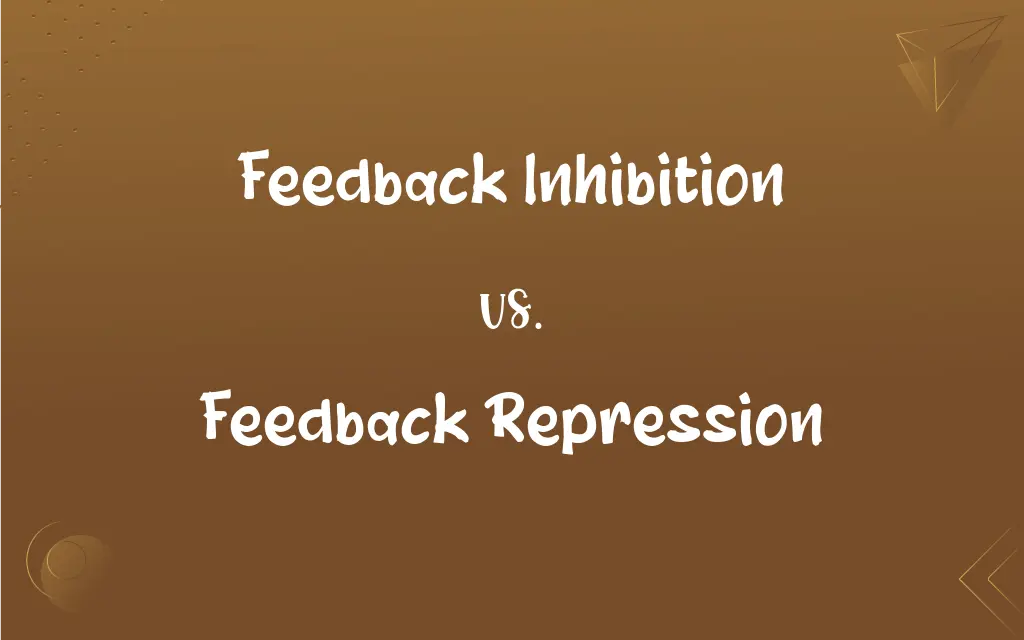Feedback Inhibition vs. Feedback Repression: What's the Difference?
Edited by Harlon Moss || By Janet White || Published on December 25, 2023
Feedback inhibition is a biochemical process where a product downregulates its own production pathway, while feedback repression involves genetic regulation to decrease production of certain enzymes.

Key Differences
Feedback inhibition is a direct biochemical mechanism where an end product of a pathway inhibits an enzyme involved in its own production. Feedback repression, however, is a gene regulatory mechanism where gene expression is reduced to decrease enzyme production.
Feedback inhibition acts quickly and reversibly on metabolic pathways by binding to enzymes. In contrast, feedback repression involves slower, more long-term changes by altering gene transcription.
The action of feedback inhibition is usually seen in enzymatic activity and is a common method of metabolic control. Feedback repression affects the synthesis of enzymes at the genetic level, impacting several biochemical pathways.
Feedback inhibition is a post-translational control mechanism, while feedback repression is a transcriptional control, affecting the very synthesis of enzymes.
Feedback inhibition can be relieved by the removal or reduction of the inhibitory product. In the case of feedback repression, alteration in gene expression patterns is required to reverse the effects.
ADVERTISEMENT
Comparison Chart
Mechanism
Biochemical, affects enzyme activity
Genetic, affects enzyme synthesis
Speed of Action
Rapid and reversible
Slower, more long-term
Level of Control
Post-translational (after protein is made)
Transcriptional (during gene expression)
Impact Area
Specific metabolic pathways
Broad spectrum of biochemical pathways
Reversibility
Relieved by removing inhibitory product
Requires changes in gene expression patterns
ADVERTISEMENT
Feedback Inhibition and Feedback Repression Definitions
Feedback Inhibition
A common mechanism in enzyme activity control.
Enzyme A's activity was reduced by feedback inhibition.
Feedback Repression
Reduction of enzyme production at the gene level.
Feedback repression decreased the synthesis of enzyme B.
Feedback Inhibition
Regulatory method to control metabolic pathways.
Feedback inhibition prevents the overaccumulation of substances.
Feedback Repression
Genetic control in response to internal signals.
High product levels triggered feedback repression of the gene.
Feedback Inhibition
A reversible control mechanism in metabolism.
The removal of excess product relieved the feedback inhibition.
Feedback Repression
Long-term regulation of metabolic pathways.
Feedback repression ensures balanced enzyme levels over time.
Feedback Inhibition
Post-translational control of enzymes.
Feedback inhibition adjusts enzyme function without new protein synthesis.
Feedback Repression
A mechanism for adjusting enzyme synthesis.
Feedback repression adapted enzyme production to the cell’s needs.
Feedback Inhibition
Inhibition of an enzyme by its product.
The high ATP levels resulted in feedback inhibition of glycolysis.
Feedback Repression
Altering gene transcription in response to metabolites.
The cell's metabolic state activated feedback repression.
FAQs
Is feedback inhibition always reversible?
Generally, it's reversible upon removal of the inhibitory product.
Can feedback inhibition be found in all cells?
It's a common feature in many metabolic pathways across organisms.
What is feedback inhibition?
It's a process where a product inhibits its own production pathway.
What is feedback repression?
It's genetic regulation that decreases enzyme production.
How fast does feedback inhibition work?
It acts rapidly and is typically reversible.
Does feedback inhibition affect DNA?
No, it acts on the enzymatic level, not on DNA.
Can feedback repression be reversed?
Yes, by altering gene expression patterns.
Does feedback repression require external factors?
It's usually triggered by internal metabolic signals.
Is feedback repression a form of genetic regulation?
Yes, it directly affects gene expression.
How does feedback repression differ from inhibition?
It involves genetic control rather than direct enzymatic control.
How does feedback inhibition affect enzyme activity?
It temporarily reduces or stops the activity of specific enzymes.
Can feedback repression impact multiple enzymes?
Yes, it can affect the synthesis of several enzymes.
Is feedback repression a quick process?
No, it's slower and involves changes in gene expression.
Which is more common, inhibition or repression?
Feedback inhibition is more commonly observed in metabolic pathways.
Is feedback repression important for cellular balance?
Yes, it helps maintain metabolic homeostasis.
Does feedback repression directly affect metabolic products?
Indirectly, by controlling enzyme levels that produce these products.
Can feedback inhibition occur in non-enzymatic pathways?
It's primarily seen in enzymatic and metabolic pathways.
Is feedback inhibition a type of cellular control?
Yes, it's a key control mechanism in cellular metabolism.
How does feedback repression respond to cellular needs?
It adjusts enzyme levels based on the cell's metabolic state.
Can feedback inhibition be part of a regulatory network?
Yes, it often interacts with other regulatory mechanisms.
About Author
Written by
Janet WhiteJanet White has been an esteemed writer and blogger for Difference Wiki. Holding a Master's degree in Science and Medical Journalism from the prestigious Boston University, she has consistently demonstrated her expertise and passion for her field. When she's not immersed in her work, Janet relishes her time exercising, delving into a good book, and cherishing moments with friends and family.
Edited by
Harlon MossHarlon is a seasoned quality moderator and accomplished content writer for Difference Wiki. An alumnus of the prestigious University of California, he earned his degree in Computer Science. Leveraging his academic background, Harlon brings a meticulous and informed perspective to his work, ensuring content accuracy and excellence.






































































